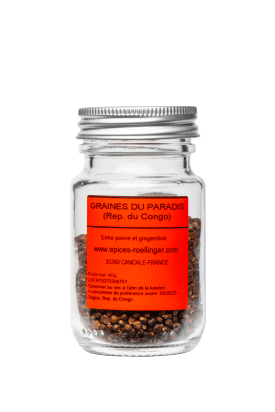Grains of Paradise

Ingredients: Grains of Paradise
Resembles both pepper and ginger.
€9.40
40 g
This product is temporarily unavailable. Receive an email as soon as this product is available again:
Recommendations
Use grains of paradise in place of black pepper.
-
Allergens
Absent, except for cross-contamination.
May contain traces of sesame, celery, mustard, soy. - Origin République du Congo
- Storage / Use In a cool, dark, dry place.
€235 / kg
Olivier Rœllinger's words
The flavor of these small seeds oscillates between the spicy bite of true peppercorns and the heat of ginger.
In the past, they were an inexpensive alternative to peppercorns and ground black pepper. During times of war or economic crisis (World War II, for example), they have often been used as a substitute.
As early as the 15th century, grains of paradise were highly sought after for their pepper-like flavor. The crew that accompanied the Portuguese explorer Prince Henry the Navigator on his search for peppercorns were thrilled to discover a seed that was ‘almost pepper’ on their voyages down the Coast of Africa.
Story
This spice goes by many names : grains of paradise, Guinea pepper, Guinea grains, and melegueta pepper. Grains of paradise belong to the Aframomum melegueta plant species which is a member of the Zingiberaceae family along with ginger and cardamom. The fragrant seeds are encased in a walnut-sized fruit. Thanks to Arab traders, grains of paradise were well known in Europe during the Middle Ages and so widely used that they made their way into drinks and wine-based sauces (like cameline sauce). Portuguese spice traders also brought grains of paradise back from the Gulf of Guinea. These grains of paradise are harvested from the wild in the Democratic Republic of the Congo.